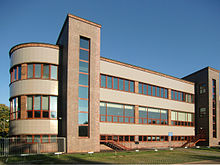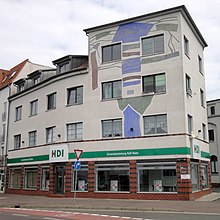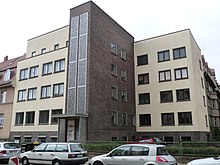Martin Knauthe
Martin Knauthe (born May 30, 1889 in Dresden ; † February 7, 1942 in the Soviet Union ) was a German architect of classical modernism .
Life
Knauthe was born in Dresden as the youngest child of a middle-class family. After his school education he attended the Dresden School of Drawing from 1906 to 1907 and the Dresden School of Applied Arts from 1907 to 1910 . In order to acquire practical knowledge, he completed an apprenticeship as a carpenter from 1908 to 1910 in the Dresden workshops for handicrafts . In order to gain further qualifications, he interned in the following years at the Dresden Art Academy and the Dresden Technical University . At the same time, he took an apprenticeship and then worked as a construction manager for the Dresden architect Oskar Menzel . This is where the first own designs were created. In 1912 Knauthe began his first independence when he and the painter Paul Freund founded the private “teaching and design studios for painting and applied arts”, in which practical exercises on a wide variety of artistic techniques were to be carried out. However, this school had to be closed in 1913 for financial reasons.
He then moved to Halle (Saale) . Here Knauthe initially worked from September 1, 1913 to September 1, 1914 in the “Office for Architecture and Urban Development” of the brothers Arthur and Bruno Föhre. That year he married Antonie Fikar. From the beginning of the First World War until the end of 1916 he worked as a war aid in the building construction department in Halle under the direction of Wilhelm Jost . During this time he has worked on many important projects. Here, too, as in the previous design offices, a lot of skill and diligence was confirmed. Knauthe then left Halle and worked in the Berlin office of the architect Bruno Paul . However, he returned to Halle at the beginning of May 1918 to work again in the Föhre architectural office, from which he left in January 1919 to start his own business. That year he was accepted into the Association of German Architects .
Before he left Halle in 1932, he had created many important building designs in the period that followed, especially for office and administrative buildings. In 1922 he formed an architectural community with Alfred Gellhorn . He left this in 1926, and with it began his most creative phase. In 1928 he entered into a second marriage with Elsa Gentzsch.
In 1931, when all architects were suffering from a lack of orders due to the global economic crisis , he went on his first information trip to the Soviet Union. Soon after, he and his wife moved there, where he worked as an architect on a large industrial project and later at the Moscow Architecture Academy. In 1936 he suffered a nervous problem. In the following year he wrote down his catalog of works that has been handed down. A short time later he was arrested and finally deported in 1938 to what is now the Autonomous Republic of the Komi in north-eastern European Russia. Knauthe died there on February 7, 1942.
Political activities
With the beginning of his independent activity Knauthe became politically very active as a communist . After the First World War he was an active member of the “Hallische Künstlergruppe”, one of the numerous revolutionary artists' associations within the “ Novembergruppe ”. As a member of the USPD / KPD, he was a city councilor in Halle from 1919 to 1924 . He was also a permanent contributor to the communist press and wrote a large number of critical articles on issues of Halle's cultural and social policy.
Buildings and designs
- 1913–1915: Clock bay at the Stadtbad (Halle)
- 1914–1916: "Model cemetery" at the small celebration hall in the Gertraudenfriedhof in Halle (approx. 8 m × 8 m), tombs and wells for cemeteries
- 1919: F. Schulze / Adolf a'Brassard tomb shop, next to the Gertraudenfriedhof in Halle (first independent work, not preserved)
- 1920/1921: Graves and memorials for the victims of the Kapp Putsch at the Gertraudenfriedhof Halle and the Ammendorf cemetery
- 1921: Conversion and expansion of the Glaucha rifle house into an office and printing building for the Klassenkampf publishing house in Halle (Saale), Lerchenfeldstraße 14
- 1922: Sernau ("Forsterhof") office building in Halle (Saale), Forsterstrasse 29 (with Alfred Gellhorn)
- 1922–1923: Laugerei of the Silberhütte "Auf Gottesbelohnung" of Mansfeld AG near Großörner (with Alfred Gellhorn, not preserved)
- 1923–1924: Edenhofer toy factory in Liebertwolkwitz , Eisenbahnstrasse 1 (with Alfred Gellhorn)
- 1924–1925: Reconstruction and expansion of the general local health insurance fund in Halle (Saale), Kleine Klausstraße 16 (with Alfred Gellhorn)
- 1926: Clubhouse (undressing hall) in the bathroom of the workers' swimming club in Halle, south of the Elisabethbrücke (not preserved)
- 1926: Boathouse of the Free Water Sports Association Böllberg-Wörmlitz in Halle (Saale), Böllberger Weg (not preserved)
- 1926–1927: Gölicke two-family house in Halle (Saale), Emil-Grabow-Straße 2
- 1926–1927: several single-family houses in Halle (Saale), Albert-Schweitzer-Straße (possibly with Alfred Gellhorn)
- 1927–1928: Three-family house Pascher in Ruhla , An der Krümme 25
- 1928: Large butcher's shop of the Halle-Merseburg consumer association in Halle (Saale), Landsberger Strasse 13–15 (not preserved)
- 1928: Commercial building of the consumer association Ammendorf in Halle (Saale), Merseburger Straße 437
- 1928: Commercial building of the Zscherben consumer association , Hauptstrasse 36
- 1927–1928: Administration building of the Health Insurance Association Saxony-Anhalt in Halle (Saale), Clara-Zetkin-Straße 15
- 1928–1929, around 1936: Children's rest home in Ruhla, Am Reuter 2
- 1928–1931: AOK administration building in Halle (Saale), Robert-Franz-Ring 16
literature
- Tino Hermann: Martin Knauthe. A Halle architect of classical modernism. Halle (Saale) 1999, ISBN 3-931919-05-6 .
- Jürgen Scharfe: The architect Martin Knauthe (1889-1942). Materials on life and work. Diploma thesis at the Martin Luther University Halle 1979. (five volumes)
Web links
- German-speaking architects in exile 1933–1945 at www.kit.edu, accessed on August 1, 2014
- Martin Knauthe . Hall and the modern. Retrieved October 24, 2019.
Individual evidence
- ↑ Sernau office building . Hall and the modern. Retrieved October 24, 2019.
- ↑ Administration and residential building . Hall and the modern. Retrieved October 24, 2019.
- ↑ General local health insurance fund AOK . Hall and the modern. Retrieved October 24, 2019.
| personal data | |
|---|---|
| SURNAME | Knauthe, Martin |
| BRIEF DESCRIPTION | German architect |
| DATE OF BIRTH | May 30, 1889 |
| PLACE OF BIRTH | Dresden |
| DATE OF DEATH | February 7, 1942 |
| Place of death | Soviet Union |



